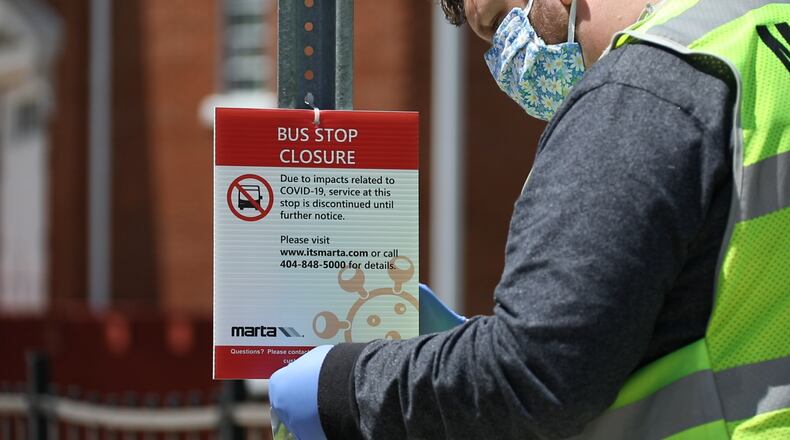This week MARTA eliminated most of its bus routes and boosted service on many remaining lines to address overcrowded buses that threatened the safety of passengers and drivers amid the coronavirus pandemic.
A few days into the experiment, MARTA says it has reduced — but not eliminated — overcrowding. It’s running twice as many buses on most of the remaining routes. And the more frequent service has usually meant fewer passengers per bus, allowing riders to spread out and maintain a safe distance from each other.
“We haven’t yet come up with a perfect solution” to overcrowding, said Collie Greenwood, MARTA’s chief of bus operations. “But every day, we’re changing it to make it better.”
MORE: A map of coronavirus cases in Georgia
MORE: Real-time stats and the latest news on the coronavirus outbreak
But the service cuts have left many regular passengers in a lurch. Scores of bus routes they rely on have been discontinued indefinitely, and they’re scrambling to find other ways to get to work and other destinations.
Some, like Dana Holmes of Stone Mountain, are turning to ride-hailing services such as Uber and Lyft that can cost far more than a $2.50 MARTA fare. She said she’s paying more than $28 a day round-trip to get to her job as a receptionist at a physical therapy clinic in Tucker.
“I pray that my bus route comes back because taking Lyft is costly, especially since I am doing it to and from work,” Holmes told The Atlanta Journal-Constitution.
The MARTA service cuts are just one of the ways the pandemic has upended the lives of metro Atlanta residents.
With many people sheltering in place, MARTA and other agencies have seen far fewer passengers and have reduced service as a result. But they have sought to maintain key routes for low-income residents who don't own cars and for essential workers who rely on transit to get to their jobs.
To protect passengers and employees, MARTA has stepped up cleaning of buses, trains and stations. It's boarding passengers at the rear door of buses to separate them from drivers. It's distributed masks and disinfectant to employees and taken other steps to keep them safe.
But MARTA also reduced the frequency of buses and trains as ridership fell. And that sometimes left the remaining buses packed with passengers, especially at rush hour. That made it hard or impossible for passengers to stay at least 6 feet apart, as health officials recommend.
One measure of the danger: 22 MARTA employees have tested positive for COVID-19, and one worker has died from the disease.
So, this week, the agency took the drastic step of reducing the number of bus routes from 110 to 41, focusing on its busiest and most critical routes. That has allowed MARTA to double the number of buses serving 34 of the remaining routes.
Though the pandemic has brought on a budget crisis at MARTA, Greenwood said the idea behind the service cuts was to keep passengers and employees safe, not to save money.
“We’re not trying to save a dime on this,” he said. “We’re just putting (buses) where the ridership was traditionally highest and where, post-COVID, ridership remains highest.”
Because MARTA quit collecting fares on buses when it began rear boarding, it can’t easily count passengers. Greenwood said it may be weeks before the agency can determine how the service cuts have affected ridership.
But the agency said the remaining routes serve about 60% of the reduced ridership it has seen during the pandemic.
Greenwood said many customers who live along discontinued bus routes can walk a half mile or a mile to another bus stop on a line that’s still operating. But he knows that’s not an option for everyone.
Mini’imah Bilal, who lives in Atlanta’s Collier Heights neighborhood, is a regular plasma donor. But the bus he used to take is no longer running.
“Unfortunately, because of the weakness and dizziness I sometimes experience after donating, I don’t feel the 1-mile-plus walk is safe for the return trip,” Bilal said. “Additionally, grocery shopping is nearly impossible now.”
Greenwood said MARTA is gathering data from the first days of the new bus system and could restore a few routes in the next two weeks. But he’s making no guarantees.
In the meantime, Greenwood said passengers should wear masks while riding. And he said those who don’t have to ride shouldn’t.
As for those who must ride but can’t, Greenwood said he’s “deeply concerned.”
“Please understand that we did not enter into this lightly,” he said. “We absolutely struggled with this. It was only in the face of a life-or-death situation that we decided to take this drastic step.”
But it’s clear plenty of people are scrambling to find rides.
Midtown resident Damian Calhoun has no car. With bus routes in his area eliminated, he now uses Uber for part of his journey to work in the radiology department at Emory University Hospital. He said he’s paying close to $30 a day.
“Looking at the figures,” Calhoun said, “I’m projected to spend close to $600 on ride shares a month now due to this move.”
About the Author
Keep Reading
The Latest
Featured



